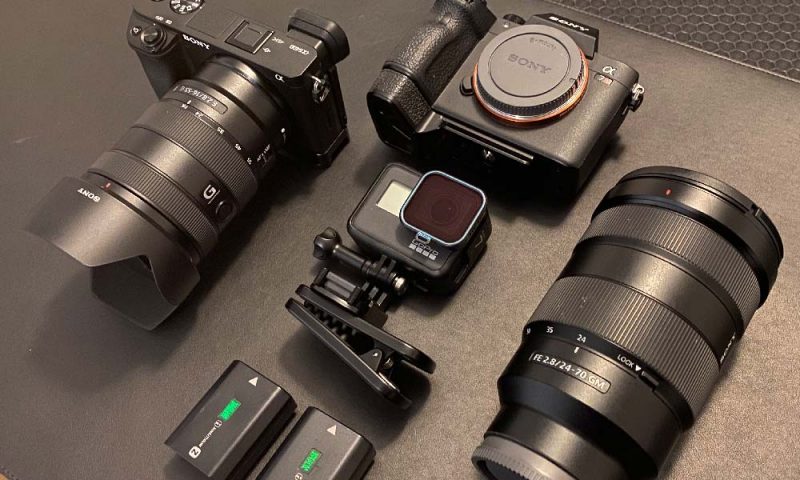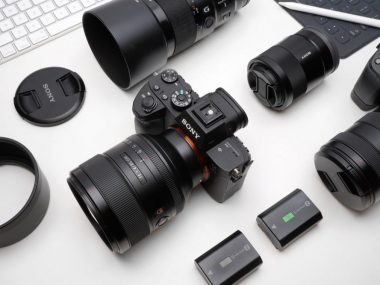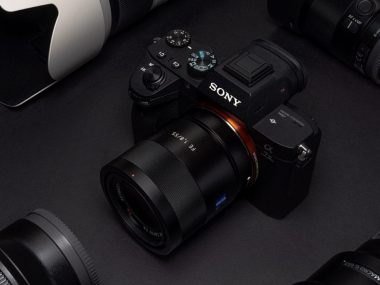Acquiring the tools of the trade is an important part of becoming a successful portrait photographer.
When you’re just starting, you may not have a large budget to work with. Luckily, you don’t need a truckload of gear to produce quality portraits.
Portrait Photography Accessories
Along with your camera and a lens, make sure you have the following 10 portrait photography accessories that every beginner should buy.
Quick List:
- Photography backdrops
- Flash or Strobes
- Light Meter
- Reflectors
- Light Diffusers
- Tripod
- Photography Camera Bag
- Lens Cleaning Kit
- Lens Filters
- Additional Lenses
1. Photography Backdrops
A photography backdrop is an essential item for studio portraits. They add style and make your portraits appear more professional, as people expect a backdrop when shooting in a studio.
Backdrops come in a wide variety of sizes, colors, and designs. You can find solid color backdrops, textured backdrops, and landscape backdrops.
If you plan on capturing full-length portraits, the backdrops should be at least 10-feet long.
Start with a selection of solid color backgrounds and add more options as your photography business grows.
You can also save money by buying paper backdrops instead of fabric backdrops.
Paper backdrops come on rolls. If the backdrop gets dirty, you rip off a portion of the paper and pull down a fresh portion.
2. Flash or Strobes – Artificial Light
Most portrait photographers have several artificial lighting devices, as proper lighting is the foundation of photography. You cannot rely on natural light to provide optimal results.
Common light sources include LED lights and flashguns. LED lights are best suited for studio sessions, as they typically need access to an electric outlet.
While you can find portable LED lights, they often have limited battery life.
Flashguns are more portable, making them useful for outdoor portraits. However, they do not provide continuous light, which can make it difficult to light your subject.
If you plan on using a flashgun, you should also invest in a light meter.
3. Light Meter
A light meter is a handheld gadget that you can use to measure available light in a scene or the direct light from one of your light sources.
Using a light meter allows you to set the correct shutter speed for more accurate exposure, especially when using an off-camera flash. Look for a light meter that includes support for flashes.
4. Reflectors
Light reflectors are useful for outdoor portraits and studio portraits. When shooting outdoors, reflectors help you fix shadows that may appear on your subject due to strong natural light.
You can also use reflectors to enhance flat lighting and achieve a more dramatic look.
Reflectors come in a variety of sizes, designs, and colors. You can hold reflectors or mount them to stands.
Some reflectors are also collapsible, allowing you to easily store and transport them with the rest of your gear.
The main color options include silver, white, gold, and black. Silver reflects more of the light source, while white helps reflect and soften the light.
Gold helps add more of a warmer color temperature to the light. Black is used for color blocking and canceling out reflections.
5. Light Diffusers
As with light reflectors, light diffusers help you control light. Instead of reflecting light, diffusers soften it to help eliminate shadows from strong lighting sources.
Diffusers also come in a variety of sizes and styles. If you plan on using LED lights or bulbs, consider buying one or more softboxes.
Softboxes are enclosures that fit over your artificial lighting source to diffuse the light.
You can also purchase handheld diffusers and fabric diffusers. As with backdrops, fabric diffusers are often large and hung from a frame or other structure.
They are placed between the lighting source and the subject to soften the light.
6. Tripod
Every photographer should have a tripod, even if they prefer to shoot handheld. A tripod helps stabilize your camera to improve focus and reduce the burden on your arms.
The main consideration when selecting a tripod is the type of tripod head. The most traditional option is the three-way (pan-and-tilt) head.
The three-way head allows you to adjust the vertical or horizontal plane one at a time. You can also pan the camera.
If you dislike having to adjust the tension knob of each axis separately, try a ball head tripod. A ball head has a single knob for loosening or tightening the ball.
By slightly loosening the ball, you gain a complete range of motion.
7. Photography Camera Bag
If you plan on shooting outdoors, you need a quality camera bag to protect your expensive gear. Ensure that your bag is large enough to hold your essential items, such as the camera body and lenses.
Look for camera bags with hard shells if you plan on traveling long distances or on an airplane with your photography gear.
The hard shell provides additional protection but also tends to increase the weight of the bag.
A canvas bag with foam protection should suffice for outdoor portrait sessions in your local area. You can get a bag with a holster strap to keep your gear conveniently within reach.
8. Lens Cleaning Kit
A lens cleaning kit may not seem like an important accessory until you forget to buy one. You may accidentally smudge the lens when adjusting the focus and need to wipe the lens.
Lens cleaning kits are affordable and easy to pack in your camera bag. The most basic kits include individual packets of cleaning wipes.
You can also find kits with microfiber cloths and small spray bottles with a cleaning solution.
9. Lens Filters
Lens filters are affordable and help you adjust the color temperature when taking photographs outdoors.
For example, during certain times of the day, the sunlight may give off more of an orange or red glow instead of a neutral white or calm yellow.
Lens filters also help eliminate lens flares and glare to produce sharper images in most lighting conditions.
A typical pack of lens filters may include blue, green, red, orange, and yellow filters for different settings.
For example, a green filter helps lighten the appearance of dark green foliage.
10. Additional Lenses
After purchasing the items listed, expand your range by purchasing additional lenses.
Many portrait photographers start with a 50 mm lens, as it offers a good balance between a wide field of view and depth. However, 50 mm lenses are not ideal for close-ups.
If you get too close with a 50 mm lens, the subject’s features may become distorted. An 85 mm lens has a narrower field of view and provides a more versatile solution for portrait photography.
You can easily use an 85 mm lens for head-and-shoulder shots, waist-level shots, and full-length shots.
The versatility of the 85 mm makes it the standard for serious portrait photographers. However, you may want a narrower field of view for headshots.
A 135 mm lens allows for close-ups and creates a beautiful background blur for dynamic portraits.
You may also want to try a zoom lens. Using a zoom lens makes it easy to try different focal lengths without switching out the lens.
Conclusion
Along with a camera, you need various portrait photography accessories to capture stunning portraits that impress your clients.
If you can only afford a few items, ensure that you have an artificial light source, light diffusers, and reflectors.
Start with the 10 accessories discussed and gradually build your inventory to expand your range and ability to experiment with different photography techniques.
*Affiliate Disclaimer - I am a proud partner of the various affiliate programs including the Amazon.com Affiliate Program. When you click on my links and make a purchase I make a commision which goes to helping me support this blog. Thanks! |



